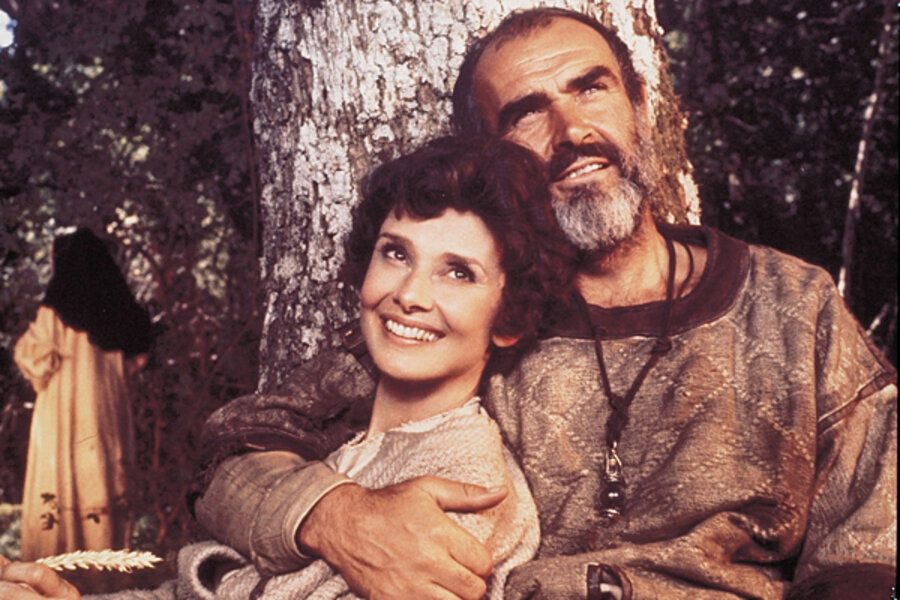A new interpretation of 'Robin Hood'? That's so 14th century.
Loading...
| Los Angeles
As “Robin Hood” star and director Russell Crowe and Ridley Scott have swashbuckled their way across oceans and continents, crossing swords with Sherwood Forest purists, their most frequent defense of the no-green-tights-here retelling is that it is “authentic” and “historically accurate.”
The problem with that answer is that some 900 years on, the true story of Robin Hood – if there even was a real Robin Hood – is virtually impossible to summon with any accuracy.
The utter lack of any meaningful paper trail before, say, the 14th century, has not in any way inhibited legions from asserting the real Robin lived at some time between 1065 to 1300. And the attempt to place Robin on terra firma is contended to this very day. Yorkshire and Nottinghamshire are locked in a battle over airports naming rights, with each claiming to be Robin’s birthplace, while at least two new tomes proving his existence are due out this year – one from
a London public records office clerk and another from a retired country gent.
IN PICTURES: Cannes Film Festival 2010
So was the popular outlaw real?
“Absolutely not,” says Thomas Hahn, a University of Rochester professor who directs Robin Hood: A Digital Archive, an online clearinghouse for all things merry. “But, on the other hand,” he adds, “what does real mean? We’re talking about him, centuries of storytellers have talked about him, and he has been reinvented for virtually every time. So, doesn’t that make him real?”
Of course, he adds, there are many who somehow feel happier knowing that their enjoyment of the familiar saga is based on an actual person.
So just what do we know, sort of?
A 1261 country ledger entry dubs a local man, “Robbenhode,” and that epithet – in various versions, from Robert Hod to Robhod – flits through obscure official pages for the next few centuries. Then, the actual Robin Hood narratives, some 45 ballads from the 14th and 15th centuries, regale listeners with the exploits of Robin as he jets from Spain to fight with Prince of Aragon, then as a seafaring bloke, and turns up yet again in the north country of England.
In other words, says La Salle University film and Robin Hood scholar, Kevin Harty, he was being reinterpreted from his earliest moments, according to the tastes of the times.
In the earliest tales, such as “Robin Hood and the Monk,” and "Robin Hood and Guy of Gisburne,” the character who would later be adapted for the silver screen by dashing Hollywood stars such as Errol Flynn and Douglas Fairbanks was savagely violent. He beheads Guy, impaling him on his own bow. And he was mostly concerned with getting his own just due – two topics that would have greatly appealed to the common men of the day.
These were the nascent stirrings of his populist tendencies, which evolved into robbing from the rich and giving to the poor.
According to HowStuffWorks.com, Joseph Ritson published Robin Hood in 1795, moving him forward in time and adding a courtly polish to his behavior. In 1820, Sir Walter Scott's Ivanhoe yanked the character back to the 12th century. This is all part of what Mr. Harty calls the tailoring of a well-loved, popular character to fit the politics of the day.
“A good case is the film, ‘Robin and Marian,’ with Sean Connery and Audrey Hepburn,” he says, which had decidedly anti-Vietnam War undertones. Errol Flynn’s version was anti-Nazi, coming out on the eve of the second World War. Another version was written by blacklisted Hollywood writers, resulting in scenes of people naming names. And a recent BBC series was for the Millennial Generation.
And so, through history, Harty adds, Robin Hood is as much an idea as a ruffian, a middle-class yeoman or fallen aristocrat – the gravestones marking his burial plot notwithstanding. On foot, on horseback, wielding a flat sword, or a long bow – they’re all Robin Hood.
Related:
'Robin Hood' at Cannes Film Festival: 'Batman Begins' meets 'Men in Tights'





